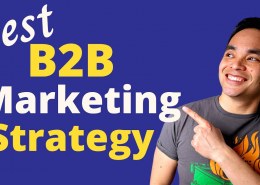Business-to-business, or B2B, marketing is the process by which a company markets its goods and services to other businesses in an effort to help those businesses run more efficiently.
Because the most successful B2B companies are embracing the digital revolution and the very best is thriving, dull marketing is no longer an option in the changing world of B2B. In order to keep up with the ever evolving B2B industry, B2B marketers continuously learn and assimilate the newest techniques and methods.
While some B2B companies are battling it out with other competitors in the industry, others are still using outdated marketing techniques. How can you develop your B2B marketing strategy in light of these ongoing changes and expand your company?
To assist you in doing that, we’ll provide you with the most modern and successful B2B marketing techniques in this post.
1. Account-Based Marketing
By focusing marketing efforts on a narrowly defined group of target clients, this tactic can assist you in attracting B2B customers for your company. This enables you to start tailored campaigns based on their particular interests and requirements.
2. Social Media marketing
the practice of using social media platforms to expand brand communities, foster relationships, and boost revenue while also attracting new customers.
Since many of your current and potential customers are already active on social media, brands have the chance to reach them there.
Decide which social media sites and online communities your target audience uses. To increase awareness and encourage engagement, develop a targeted and dependable strategy. 93% of B2B organizations use LinkedIn as their preferred social media platform for content sharing.
3. Content Marketing
Businesses can use content marketing to promote their thought leadership while also generating leads. By producing instructive and snackable digital material, such as articles, white papers, or infographics, you may demonstrate your industry’s expertise and credibility. The audience you’re looking for can be attracted with the aid of a good lead generating plan.
4. Paid Media
Extending the reach of your content and messaging to a specific audience using paid techniques like sponsorships and adverts. Paid media overlaps with the aforementioned tactics, but it typically has its own framework and experts.
a dependable way to target audiences you might not have otherwise been able to reach, increase the effect of your branding, garner clicks and engagement, and promote conversions.
To assure a high return on investment, create goal-oriented paid advertising campaigns with continuous monitoring. To increase the impact and value of your top-performing organic content, boost it (on social media and elsewhere).
5. Gamification
Gamification uses games or gamelike elements to make marketing and business initiatives more exciting, interactive and memorable. Loyalty programs in which customers collect points; digital channels that allow users to reap rewards based on engagement; and playful, interactive calls to action are a few examples of gamification. All of these can help set your brand apart from the competition.
6. Retargeting
Retargeting has been a well-liked digital marketing strategy for a while. However, a major search engine’s efforts to phase out third-party cookies on its browsers, mean that you might soon require new strategies for accurately identifying, tracking, and focusing on your audience.
However, bear in mind that only the third-party cookies on its browsers will be prohibited as a result.
First-party cookies that keep track of basic information about the users of your own site may still be in use. In the future, some marketers might search for ways to utilize this first-party data more effectively, learning more about their ideal client’s habits and interests and using that knowledge to connect with the appropriate prospects.
7. Search Engine Optimization
Content optimization is done specifically to increase the likelihood that relevant consumers will find it on search engines.
The main source of traffic to websites is organic search. Over two thirds of all traffic is attributed to search. By attracting a steady stream of new customers to your brand, well-optimized content pieces can deliver enormous sustained value.
Today, art and science are combined to create an efficient B2B SEO strategy. Although there are undoubtedly technical factors at play, creating high-quality content with a focus on searcher intent is the key to making it rank well. The methods used by search engines to evaluate these criteria are becoming a lot more sophisticated.
8. Micro-Moment Marketing
Micro-moments are the brief intervals that occur during the B2B buyer’s journey and have an impact on the buyer’s choices and preferences. Micro-moments can happen whenever consumers reach for their phones to act on an inclination to learn, do, watch, or purchase something in today’s meandering and fragmented world. To succeed, make sure your marketing is mobile-friendly and relevant.
9. Direct Mail
In the early stages of the buyer’s journey, social media advertising and search engine optimization (SEO) are excellent for raising awareness, but they are less successful at driving sales. Both things are possible with direct mail.
Direct mail attracts interest at the top of the marketing funnel. It is a catalyst at the very bottom that encourages spectators to act. Direct mail that is branded and individualized is the most efficient way to contact target consumers, according to a poll of 600 marketers.

